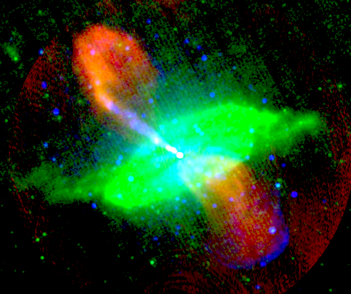電波星系
電波星系是在無線電波長上非常明亮的星系。它們有活躍星系核,或者說,可能有類星體、耀變體。它們從10 MHz到100 GHz的光度流量累計達1039 W。[1] 在星系中央,兩道噴流和周圍的介質發生了相對論性發光,發射了同步輻射。電波星系可以在遙遠的距離外被觀測到,可以做為觀測宇宙學上可貴的工具。研究集中在星際物質和星系團上。
發射過程
[編輯]
來自電波喧噪活躍星系的電波發射是同步加速輻射,被臆測是非常平滑的、自然的寬頻和高度偏振。這暗示發射電波的電漿體包含,至少是,有相對論性速度(洛侖茲因子大約在~104)的電子和磁場。因此電漿體必然是中性的,質子或正子必然是其中的成分之一,但是沒有辦法從同步加速輻射中直接觀察出微粒的種類。而且,沒有辦法從觀測中確定微粒和磁場的能量密度(也就是說,相同的同步加速輻射可以來自強磁場的少數幾個電子,也可以是來自弱磁場的大量電子)。它是可能在特定的發射區域內,以給定的發射率,在最低的能量密度下測量出的最低能量狀態(Burbidge 1956),但多年來沒有特別的理由可以相信在真實狀況中,任何地方的能量都在極小能量的附近。
一種與同步加速輻射是姐妹程序的是逆康普頓過程,相對論性的電子與四周的光子作用,經由湯木生散射提高能量。來自電波喧噪源的逆康普頓發射特別重要的結果是X射線(e.g. Croston et al. 2005),因為他只與電子的密度有關(和已經知道的光子密度),對逆康普頓散射的測量允許我們估計粒子和磁場的能量密度(依賴某些模型)。這可以用來論證是否多數來源的情況都接近於極小值能量的附近。
同步加速輻射沒有被限制在電波的波長範圍內:如果電波源的粒子能被加速到足夠的能量,在紅外線、光學、紫外線或甚至在X射線,也都能檢測到在電波區域的特性。但是,後述狀況的電子必須獲得超過1Tev的能量,而在通常狀態下的磁場,電子很難獲得如此高的能量。再一次,偏振和連續光譜被用於區別來自其他過程的同步加速輻射。噴流和熱點(見下文)是常見的高頻同步加速輻射的來源。在觀測上要區別同步加速輻射和逆康普頓輻射是很困難的,幸好在進行的過程中在一些物體上會有一些歧異,特別是在X射線。
在產製相對論粒子的過程,同步加速輻射和逆康普頓輻射都被認為是粒子加速器。 費米加速在電波喧噪活躍星系中似乎是有效的粒子加速過程。
電波星系的結構
[編輯]電波星系結構多樣,其實就是大家給照片上的不同形狀起了不同名字。一個星系可以包含多種結構。有叫lobes的,plumes的等等。
有叫噴流(jets)的。噴流是一個或兩個很長很窄的形狀,一頭是中心,一頭是lobes(最著名的例子是處女座星團中的室女A星系(M87))
關於無線電結構最被廣泛接受的模型是1974年的兩篇論文[2][3],它們說,噴流這種結構是活躍星系核附近的 高能粒子發射、磁場作用的痕跡,所以「噴流」也指這種變化過程。
1974年,Fanaroff和Riley將電波源分為兩類[4] ,現在稱這為Fanaroff–Riley 分類,分為兩種,FRI和FRII。

術語
[編輯]相關條目
[編輯]延伸讀物
[編輯]- Melia, Fulvio, The Edge of Infinity. Supermassive Black Holes in the Universe 2003, Cambridge University Press, ISBN 978-0-521-81405-8 (Cloth)
參考資料
[編輯]- Barthel P.D., Is every quasar beamed?, 1989, Astrophys. J., 336, 606
- Blandford R.D., Rees M.J., A `twin-exhaust' model for double radio sources, 1974, MNRAS, 169, 395
- Burbidge G., On synchrotron radiation from Messier 87, 1956, Astrophys. J., 124, 416
- Croston J.H., Hardcastle M.J., Harris D.E., Belsole E., Birkinshaw M., Worrall D.M., An X-ray study of magnetic field strengths and particle content in FRII radio sources, 2005, ApJ, 626, 733
- Daly R.A, Djorgovski S.G., A Model-Independent Determination of the Expansion and Acceleration Rates of the Universe as a Function of Redshift and Constraints on Dark Energy, 2003, Astrophys. J., 597, 9
- Fanaroff B.L., Riley J.M., 1974, The morphology of extragalactic radio sources of high and low luminosity, 1974, MNRAS, 167, 31P
- Garrington S., Leahy J.P., Conway R.G., Laing R.A., A systematic asymmetry in the polarization properties of double radio sources, 1988, Nature, 331, 147
- Hardcastle M.J., Birkinshaw M., Cameron R.A, Harris D.E., Looney L.W., Worrall D.M., Magnetic field strengths in the hotspots and lobes of three powerful FRII radio sources, 2003, Astrophys. J., 581, 948
- Kraft R.P., Vázquez S., Forman W.R., Jones C., Murray S.S., Hardcastle M.J., Worrall D.M., X-ray emission from the hot ISM and SW radio lobe of the nearby radio galaxy Centaurus A, 2003, Astrophys. J., 592, 129
- Laing R.A., The sidedness of jets and depolarization in powerful extragalactic radio sources, 1988, Nature, 331, 149
- Laing R.A., Bridle A.H., Relativistic models and the jet velocity field in the radio galaxy 3C31, 2002, MNRAS, 336, 328
- Leahy J.P., DRAGNs, 1993, in Röser, H.-J., & Meisenheimer, K. (eds). 1993. Jets in Extragalactic Radio Sources. Berlin: Springer-Verlag.
- Meisenheimer K., Röser H.-J., Hiltner P.R., Yates M.G., Longair M.S., Chini R., Perley R.A., 1989, The synchrotron spectra of radio hotspots, 1989, Astron. Astrophys., 219, 63
- Owen F.N., Ledlow M.J., The FRI/II Break and the Bivariate Luminosity Function in Abell Clusters of Galaxies, 1994, in The First Stromlo Symposium: The Physics of Active Galaxies. ASP Conference Series, Vol. 54, 1994, G.V. Bicknell, M.A. Dopita, and P.J. Quinn, Eds., p.319
- Scheuer P.A.G, Models of extragalactic radio sources with a continuous energy supply from a central object, 1974, MNRAS, 166, 513.
外部連結
[編輯]- Atlas of DRAGNs (頁面存檔備份,存於網際網路檔案館) A collection of radio images of the 3CRR catalogue of radio-loud active galaxies.
- Radio and optical images of radio galaxies and quasars (頁面存檔備份,存於網際網路檔案館)
- The on-line 3CRR catalogue of radio sources
- ^ FANAROFF-RILEY CLASSIFICATION. [2019-05-04]. (原始內容存檔於2021-03-20).
- ^ Scheuer, PAG. Models of extragalactic radio sources with a continuous energy supply from a central object. Monthly Notices of the Royal Astronomical Society. 1974, 166 (3): 513–528. Bibcode:1974MNRAS.166..513S. doi:10.1093/mnras/166.3.513.
- ^ Blandford RD; Rees MJ. A 'twin-exhaust' model for double radio sources. Monthly Notices of the Royal Astronomical Society. 1974, 169 (3): 395–415. Bibcode:1974MNRAS.169..395B. doi:10.1093/mnras/169.3.395.
- ^ Fanaroff, Bernard L., Riley Julia M.; Riley. The morphology of extragalactic radio sources of high and low luminosity. Monthly Notices of the Royal Astronomical Society. May 1974, 167: 31P–36P. Bibcode:1974MNRAS.167P..31F. doi:10.1093/mnras/167.1.31p.

